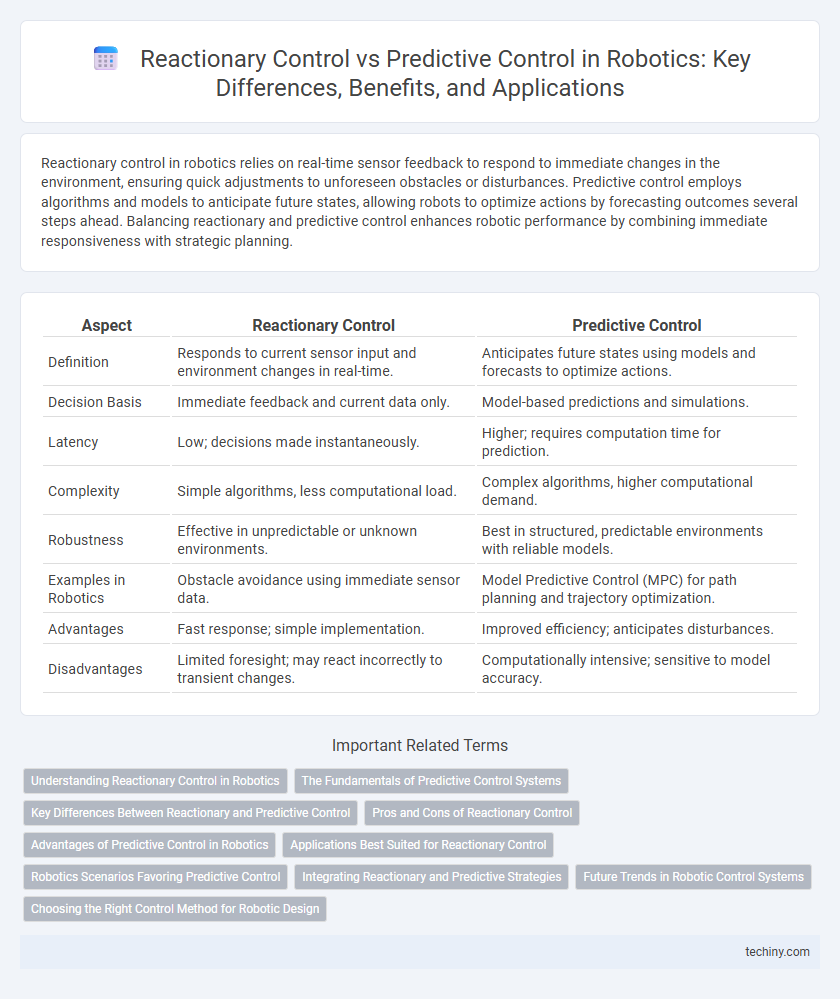Reactionary control in robotics relies on real-time sensor feedback to respond to immediate changes in the environment, ensuring quick adjustments to unforeseen obstacles or disturbances. Predictive control employs algorithms and models to anticipate future states, allowing robots to optimize actions by forecasting outcomes several steps ahead. Balancing reactionary and predictive control enhances robotic performance by combining immediate responsiveness with strategic planning.
Table of Comparison
| Aspect | Reactionary Control | Predictive Control |
|---|---|---|
| Definition | Responds to current sensor input and environment changes in real-time. | Anticipates future states using models and forecasts to optimize actions. |
| Decision Basis | Immediate feedback and current data only. | Model-based predictions and simulations. |
| Latency | Low; decisions made instantaneously. | Higher; requires computation time for prediction. |
| Complexity | Simple algorithms, less computational load. | Complex algorithms, higher computational demand. |
| Robustness | Effective in unpredictable or unknown environments. | Best in structured, predictable environments with reliable models. |
| Examples in Robotics | Obstacle avoidance using immediate sensor data. | Model Predictive Control (MPC) for path planning and trajectory optimization. |
| Advantages | Fast response; simple implementation. | Improved efficiency; anticipates disturbances. |
| Disadvantages | Limited foresight; may react incorrectly to transient changes. | Computationally intensive; sensitive to model accuracy. |
Understanding Reactionary Control in Robotics
Reactionary control in robotics relies on immediate sensor feedback to adjust actions in real-time, enabling robots to respond swiftly to unpredicted changes in their environment. This control approach emphasizes reflexive behaviors, often implemented through simple algorithms such as Proportional-Derivative (PD) controllers, which prioritize stability and responsiveness over long-term planning. Understanding reactionary control is crucial for applications where rapid adaptation is necessary, including obstacle avoidance and dynamic interaction with unpredictable surroundings.
The Fundamentals of Predictive Control Systems
Predictive control systems anticipate future states of robotic mechanisms by utilizing dynamic models and real-time data, enabling optimized decision-making and smoother task execution. Unlike reactionary control, which responds solely to immediate feedback, predictive control leverages model-based forecasts to minimize errors and improve stability in complex environments. Key techniques include Model Predictive Control (MPC), which solves optimization problems over a moving time horizon to adjust control inputs proactively.
Key Differences Between Reactionary and Predictive Control
Reactionary control in robotics relies on real-time sensor feedback to respond immediately to environmental changes, making it suitable for dynamic, unpredictable settings. Predictive control uses mathematical models and future state estimations to optimize system performance over time, enabling proactive decision-making and smoother operation. The key difference lies in reactionary control's reactive nature versus predictive control's anticipatory strategy, impacting robot adaptability, efficiency, and complexity.
Pros and Cons of Reactionary Control
Reactionary control in robotics offers robust adaptability to unexpected environmental changes, ensuring real-time responses that enhance system reliability in dynamic settings. However, it suffers from latency issues, as responses are only triggered after a stimulus is detected, potentially leading to suboptimal performance in fast-paced tasks. The lack of anticipatory adjustments limits its efficiency compared to predictive control, especially in scenarios requiring proactive maneuvering or complex interaction planning.
Advantages of Predictive Control in Robotics
Predictive control in robotics enhances system performance by anticipating future states and adjusting actions proactively, leading to smoother and more precise motion. It improves handling of constraints and disturbances by optimizing control inputs over a prediction horizon, reducing errors and energy consumption. This approach enables robots to operate effectively in dynamic and uncertain environments, outperforming reactionary control that relies solely on immediate feedback.
Applications Best Suited for Reactionary Control
Reactionary control excels in applications requiring rapid response to unexpected environmental changes, such as robotic obstacle avoidance and real-time emergency shutdowns in industrial automation. Its strength lies in processing sensor feedback instantly without reliance on predictive modeling, making it ideal for dynamic or unpredictable environments. Tasks like drone collision avoidance, autonomous vehicle hazard detection, and adaptive robotic grasping benefit from the immediacy and robustness of reactionary control systems.
Robotics Scenarios Favoring Predictive Control
Robotics scenarios favoring predictive control often involve complex, dynamic environments where anticipatory adjustments improve system performance and safety. Tasks such as autonomous navigation, robotic manipulation, and human-robot interaction benefit from model-based predictions to handle uncertainty and varying external conditions effectively. Predictive control algorithms utilize environmental data and system models to optimize control inputs over a future horizon, enhancing precision and robustness in robotic operations.
Integrating Reactionary and Predictive Strategies
Integrating reactionary and predictive control strategies in robotics enhances adaptive performance by combining real-time responsiveness with foresight-driven planning. Reactionary control processes immediate sensor inputs to address unexpected changes, while predictive control uses models and data forecasts to optimize actions over time. This hybrid approach facilitates robust decision-making, improving efficiency and stability in dynamic environments.
Future Trends in Robotic Control Systems
Future trends in robotic control systems emphasize the integration of predictive control techniques to enhance adaptability and accuracy in dynamic environments. Reactionary control relies on immediate sensor feedback, while predictive control leverages machine learning algorithms and model-based approaches to forecast system behavior and optimize decision-making. Emerging technologies in neural networks and real-time data analytics are driving the shift towards more autonomous and efficient robotic control frameworks.
Choosing the Right Control Method for Robotic Design
Reactionary control in robotics relies on real-time sensor feedback to adjust movements instantly, making it ideal for unpredictable environments where immediate response is critical. Predictive control uses models and algorithms to forecast future states and optimize actions, enhancing performance in structured settings with known variables. Choosing between reactionary and predictive control depends on task complexity, environmental stability, and computational resources available in the robotic system.
reactionary control vs predictive control Infographic

 techiny.com
techiny.com